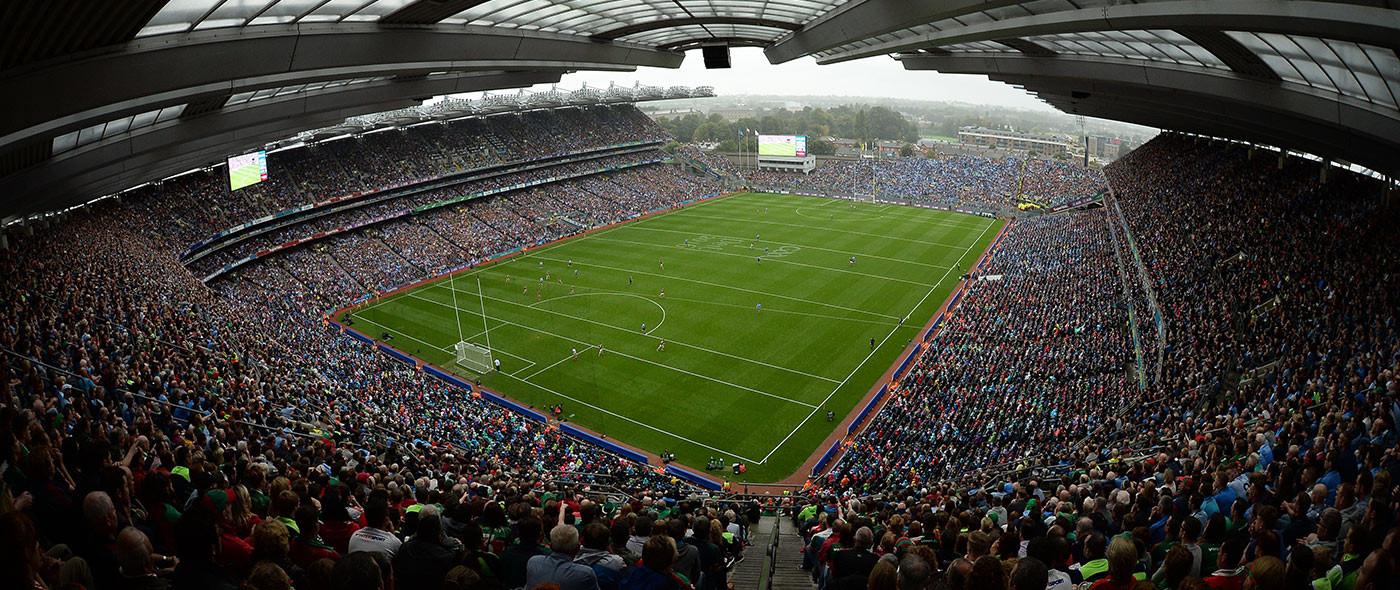Are you curious about the difference between hurling and Gaelic football, Ireland’s popular sports? This guide from CAUHOI2025.UK.COM breaks down the rules, equipment, and history to clarify their unique features. Understand the key distinctions between these traditional Irish games.
1. What is Hurling?
Hurling is an outdoor team sport of ancient Gaelic Irish origin, played with sticks (hurleys) and a ball (sliotar). Often described as the fastest game on grass, hurling demands exceptional skill, athleticism, and courage. Two teams of 15 players compete to score by hitting or carrying the sliotar into the opposing team’s goals or over the crossbar.
1.1. Key Aspects of Hurling
- Objective: Score points by hitting the sliotar over the crossbar (1 point) or into the net (3 points).
- Equipment: Hurley (stick), sliotar (ball), helmets, and protective gear.
- Skills: Striking, catching, passing, running, and tackling.
Hurling is more than just a sport; it’s a cultural phenomenon deeply rooted in Irish history and tradition. The GAA estimates that over 100,000 people attend hurling matches annually in Ireland.
2. What is Gaelic Football?
Gaelic football is another popular Irish team sport that combines elements of soccer and rugby. Two teams of 15 players compete to score by kicking or hand-passing the ball into the opposing team’s goals or over the crossbar. Gaelic football emphasizes athleticism, teamwork, and tactical awareness.
2.1. Key Aspects of Gaelic Football
- Objective: Score points by kicking or hand-passing the ball over the crossbar (1 point) or into the net (3 points).
- Equipment: Football, jerseys, and optional protective gear.
- Skills: Kicking, hand-passing, catching, running, and tackling.
Gaelic football is known for its fast-paced action and exciting matches. According to the GAA, it’s the most popular sport in Ireland, with millions of fans following the games.
3. Hurling vs. Gaelic Football: Key Differences
While both sports share common elements, several key differences distinguish hurling from Gaelic football. Let’s explore these differences in detail:
3.1. Equipment
The most obvious difference lies in the equipment used:
- Hurling: Players use a hurley (a wooden stick) to strike the sliotar (a small, hard ball).
- Gaelic Football: Players use a round leather football, similar in size to a soccer ball.
3.2. Ball Handling
The rules for handling the ball differ significantly:
- Hurling: Players can catch the sliotar in their hand, but they must strike it with the hurley to advance it. They can also carry the sliotar on the hurley for a limited number of steps.
- Gaelic Football: Players can kick or hand-pass the ball. They can also carry the ball for a maximum of four steps, after which they must bounce or solo (kick the ball into their own hands).
3.3. Physicality
While both sports are physically demanding, they differ in their style of physicality:
- Hurling: Known for its high-speed action and aerial duels, hurling often involves more open collisions and skillful stick work.
- Gaelic Football: Emphasizes running, tackling, and strategic positioning, with a greater focus on ground play.
3.4. Scoring
The scoring system is the same for both sports:
- Over the Crossbar: 1 point
- Into the Net: 3 points
3.5. Popularity and Geographical Distribution
- Hurling: Traditionally more popular in the south and east of Ireland, particularly in counties like Cork, Kilkenny, and Tipperary.
- Gaelic Football: Has a broader appeal across the country, with strongholds in counties like Kerry, Dublin, and Tyrone.
| Feature | Hurling | Gaelic Football |
|---|---|---|
| Equipment | Hurley (stick), Sliotar (ball) | Football |
| Ball Handling | Strike with hurley, carry on hurley | Kick or hand-pass, bounce/solo after 4 steps |
| Physicality | High-speed, aerial duels, stick work | Running, tackling, strategic positioning |
| Geographical Base | South and east of Ireland | All Ireland |
| Gameplay | Faster, more aerial | More ground-based, tactical |
4. What Makes Both Games So Popular?
Both hurling and Gaelic football are deeply ingrained in Irish culture and identity. Several factors contribute to their enduring popularity:
- Amateur Status: Players compete for the love of the game and their local community, fostering a strong sense of camaraderie and pride. According to a 2022 study by the Economic and Social Research Institute (ESRI) in Ireland, over 99% of GAA players are unpaid amateurs.
- Community Involvement: The GAA is a community-based organization, with local clubs serving as social hubs and promoting a sense of belonging.
- Tradition and History: Both sports have ancient roots, dating back centuries, and are seen as important symbols of Irish heritage.
- Excitement and Skill: The fast-paced action, skillful displays, and passionate rivalries make hurling and Gaelic football incredibly exciting to watch.

5. Understanding the All-Ireland Championships
The pinnacle of the GAA season is the All-Ireland Championships for both hurling and Gaelic football. These prestigious competitions culminate in the All-Ireland Finals, held annually at Croke Park in Dublin.
5.1. Croke Park
Croke Park is the largest sports stadium in Ireland, with a capacity of over 82,000. It serves as the headquarters of the GAA and the venue for the All-Ireland Finals. The atmosphere at Croke Park on All-Ireland Final day is electric, with passionate fans from all over the country converging to support their teams.
5.2. The Significance of the All-Ireland Finals
Winning an All-Ireland title is the ultimate goal for any GAA player. The All-Ireland Finals are not just sporting events; they are cultural celebrations that bring communities together and showcase the best of Irish sport.
6. How to Experience Hurling and Gaelic Football in Ireland
If you’re visiting Ireland and want to experience the thrill of hurling and Gaelic football, there are several ways to do so:
- Attend a Match: Check the GAA website for match schedules and ticket information. Local club games can be a great way to experience the sports at a grassroots level.
- Visit the GAA Museum: Located at Croke Park, the GAA Museum offers a fascinating insight into the history and culture of Gaelic games.
- Take a Stadium Tour: Croke Park offers stadium tours that allow you to explore the inner workings of this iconic venue.
- Try it Yourself: Some GAA clubs offer introductory sessions for visitors who want to try their hand at hurling or Gaelic football.

7. Hurling and Gaelic Football in the United States
While hurling and Gaelic football are primarily associated with Ireland, they have a growing presence in the United States. The North American GAA (NA GAA) oversees the development and promotion of Gaelic games across the continent.
7.1. Opportunities to Play and Watch
- GAA Clubs: Many cities across the United States have GAA clubs that offer opportunities to play hurling and Gaelic football.
- NA GAA Championships: The NA GAA holds annual championships that attract teams from all over North America.
- Irish Cultural Centers: Some Irish cultural centers in the United States host Gaelic games events and promote the sports within their communities.
7.2. The Growth of Gaelic Games in the US
The popularity of hurling and Gaelic football in the United States is on the rise, fueled by a growing interest in Irish culture and a desire to connect with heritage. The NA GAA is working to expand the reach of Gaelic games and provide more opportunities for Americans to get involved.
8. Health and Fitness Benefits
Participating in hurling and Gaelic football offers numerous health and fitness benefits:
- Cardiovascular Fitness: Both sports involve a lot of running, which improves cardiovascular health.
- Strength and Endurance: Hurling and Gaelic football require strength, power, and endurance.
- Agility and Coordination: The fast-paced action and skillful movements enhance agility and coordination.
- Teamwork and Social Skills: Playing in a team fosters teamwork, communication, and social skills.
- Mental Well-being: Exercise has been shown to improve mood, reduce stress, and boost self-esteem. According to the Mayo Clinic, regular physical activity can be a powerful tool for managing stress and improving mental health.
9. Dispelling Common Misconceptions
There are several common misconceptions about hurling and Gaelic football:
- They are the same sport: As we’ve discussed, they are distinct sports with different rules, equipment, and playing styles.
- They are only for Irish people: While they are deeply rooted in Irish culture, anyone can play and enjoy these sports.
- They are too dangerous: While they are physically demanding, safety is a priority, and players wear protective gear to minimize the risk of injury.
10. How CAUHOI2025.UK.COM Can Help You Learn More
At CAUHOI2025.UK.COM, we’re dedicated to providing accurate, reliable, and easy-to-understand information about a wide range of topics, including Irish sports. Whether you’re a seasoned GAA fan or a curious newcomer, we can help you learn more about hurling and Gaelic football.
10.1. Resources Available
- Detailed Articles: Explore our in-depth articles on the history, rules, and strategies of hurling and Gaelic football.
- Expert Insights: Benefit from the knowledge of our experienced writers and researchers.
- Community Forum: Connect with other GAA enthusiasts and ask questions in our community forum.
10.2. Contact Us
Do you have a specific question about hurling or Gaelic football? Contact us at CAUHOI2025.UK.COM! Our team is here to help you find the answers you need. You can reach us at our New York office: Equitable Life Building, 120 Broadway, New York, NY 10004, USA, or call us at +1 (800) 555-0199.
11. FAQs About Hurling and Gaelic Football
Here are some frequently asked questions about hurling and Gaelic football:
- What is a sliotar? A sliotar is the small, hard ball used in hurling.
- What is a hurley? A hurley is the wooden stick used to strike the sliotar in hurling.
- How many players are on a hurling team? 15 players.
- How many players are on a Gaelic football team? 15 players.
- How many points is a goal worth in hurling? 3 points.
- How many points is a goal worth in Gaelic football? 3 points.
- How do you score a point in hurling? By hitting the sliotar over the crossbar.
- How do you score a point in Gaelic football? By kicking or hand-passing the ball over the crossbar.
- Where are the All-Ireland Finals held? Croke Park, Dublin.
- What is the NA GAA? The North American GAA, which promotes Gaelic games in North America.
12. Call to Action
Ready to delve deeper into the world of hurling and Gaelic football? Visit CAUHOI2025.UK.COM today to explore our comprehensive resources, connect with other fans, and get all your questions answered! Discover the excitement, tradition, and community spirit of these unique Irish sports. Don’t miss out – start your GAA journey with CauHoi2025.UK.COM now!
